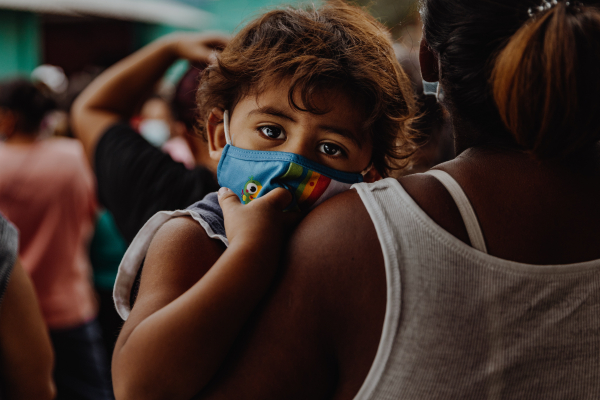The first year of adoption can be challenging. It is a year of bonding and attaching as a family. The child is growing culturally and developmentally in a new home with a new family. For our son, he experienced many firsts. His first holidays spent with family. His first time visiting different places across the country and his first time frequently flying on an airplane. His first time watching his first basketball and baseball game live. His first time being in a school. His first time having group soccer lessons. His first experience being in a tumbling class. And while he was beginning to get his second operation for the year, the pandemic hit.
My husband and I were in the middle of getting our son accessed for preschool when I got the text message from my principal that our school would shut down for about a month. That date was March 13th, 2020. The month-long shutdown grew to a year. So instantly, the world that was slowly opening up to him shut down again due to the pandemic. Adoption as a whole was affected, and of course, we were not the only family involved. Other families in the international adoption community were affected as well within the first year of adoption. Our first year in adoption began without a pandemic and ended with a pandemic. Others started their placement journey amid the pandemic. Adoption Education was still needed during the pandemic. In both cases, bonding and adjusting happened during extraordinary circumstances. Through the best of times and the worst of times, I believe that the pandemic changed adoption as a whole.
The Immediate Consequence of the Pandemic
According to the Congressional Coalition for Adoption Institute, over 437,000 children live in the U.S. foster care system, and the number has been rising. Over 125,000 of these children are eligible for adoption. On average, they will wait four years for an adoptive family. Adoption can be a challenging experience without the pandemic, but the process is complicated throughout a pandemic. Babies are still being born, and there is still a need for adoptions to take place.
While the need for adoptions is there, statistics show that the pandemic will reduce the number of adoptions, according to Becky Fawcett, president of Helpusadopt.org. This national grant program helps parents with the costs of adoptions. The fewer numbers are due to delays in the way that the adoption is processed. As we’ve experienced through the adoption of our second child during the pandemic, in-home visits, in-person training, and other supports and services have changed. On top of all of that, there are delays in paperwork and court dates. Kristen Hamilton, Director of Strategic Initiatives and Communication for the National Council for Adoption, said these things have “impacted families across the board.” Hamilton means that adoption is impacted by families just thinking about adopting and people amidst the adoption process.
With the number of kids in need of adoption, agencies still need to recruit families willing to be flexible under the circumstances. Some programs chose not to accept new families until the pandemic calmed down. The Gladney Center for Adoption is one of those agencies that were willing to take more families regardless of the circumstances. As a result, they were able to place children despite the circumstances.
Adoption Education During the Pandemic
Adoption Education in the adoption community is not uncommon. While many adoption classes were in-person in the past, some agencies now require a hybrid method to adopt education. For example, my husband and I had to complete our adoption education requirements for our adoption program, and we were first required to come to meet for classes in person in New York. Now, our classes were done through Zoom, or we used Adoption Learning Partners.
The Gladney Adoption Agency revamped its adoption education programs-AdoptEd and Gladney University. The AdoptED program is Gladney’s resource to address the issues of teen pregnancy and school dropout rates. The program offers adoption as a resource for families to help adoption become successful. The program was already planning to create an option for virtual learning. Instead of waiting to create the virtual platform, they moved the timeline forward. The Gladney University program has clients and professionals with the knowledge to help provide positive and healthy outcomes for the children we serve.
Another form of adoption education at Gladney is Gladney University. Gladney University provides adoptive parents with education and support before, during, and after their adoption. Additionally, Gladney University offers medical professionals, counselors, social service advocates, community members, relevant and engaging education, virtual and in-person, adoption education, and child welfare resources. For Jennifer Lanter, Vice President of Communications at Gladney Adoption Agency, her first thought was about teaching. She felt, along with Zoom and Adoption Learning Partners, that the education had to be digital. “I didn’t exactly know how it would work, but I had faith in the team and knew we had a lot of smart and skilled people who could help turn our Gladney University and AdoptED programs into a digital or virtual format,” she explained. So Lanter, along with her team, set the wheels in motion for virtual learning. This shift allowed the needed adoption programs to continue instead of shutting down.
Domestic Adoptions and the Pandemic
Paperwork delays and courthouse closures stalled domestic adoption. Cases slowed regardless of the adoption being through foster care or private adoption. With the closure of courthouses, non-essential workers were sent home, and the essential workers were understaffed. This delayed the legalization of adoptions. The article What It’s Like Trying to Adopt a Child During the Coronavirus Pandemic, by Jo Cairo shares various families’ adoption stories. The article shares one report of a couple who legally adopted their child during the pandemic and another family with a long delay.
Twyla and Roger, who live in Tennessee, brought home their baby, Nancy, from the hospital in September 2019. They were working on finishing up legalizing the adoption with their agency when the pandemic hit the country. These closures caused their adoption process to be on hold because courthouses shut down. Eventually, the couple was given a court date to finalize the adoption. The child, Nancy, was officially adopted on May 6th. The legalization process was through video conferences with officials and family present. The occasion was not in-person, but they were thrilled to adopt their daughter.
Not all stories are like Twyla and Roger. Robyn, a single mother and a professional organizer in Los Angeles, did not turn around as quickly as Twyla and Roger. Already a single mother to a 15-year-old, Robyn hoped to adopt another girl she met through the charity Kidsave. At the time of the article, the county was not doing in-person visits or virtual visits between prospective parents and children; thus, Robyn needed to wait until life in the pandemic calmed down.
Agencies fear that prospective families would not want to continue with adoption because of the wait involved in the process. It was the challenge of the agencies to do what they could to keep recruiting and keep prospective parents involved and engaged in the process. Also, the agencies’ challenge is to provide emotional support for the adoptive families as a whole.
International Adoptions and the Pandemic
With cases still on board in various agencies, families were still to travel, and then when they traveled, they faced challenges and differences in procedure. Rules changed for intercountry adoption, and the families had to adjust accordingly. For the Taiwan program at Gladney, it seemed they could travel after waiting a couple of months. The families were able to discuss the differences with me when I interviewed them upon return from Taiwan.
Briana and Brodie Heflin adopted a sibling set from Taiwan before the pandemic and after the pandemic. They explain the differences in the article The Story of a Family’s Transcultural Adoptions from Taiwan. In their adoption before the pandemic in 2018, they were required to visit Taiwan on two separate one-week trips due to the agency standards. They could take their sons with them when they visited Taiwan the second time for the placement. They met other families adopting from Taiwan. Also, they met up with Taiwanese friends. They went to pick up their daughter and to view the rest of the country culturally.
With their second transcultural adoption, the total trip was four weeks. The government required them to be under strict quarantine for two weeks. They then had one week of “self-health management” needed by the agency. The family needed to monitor their symptoms but could travel around Taiwan. They did not bring their biological sons with them the second time because of the strict quarantine requirements. They took their daughter on the trip and used the time to bond with their daughter and her birth family. The government typically requires couples to quarantine in two separate rooms. Still, thankfully, Briana and Brodie were able to stay together in their room because their daughter needed both of their care. Despite these odds, Briana and Brodie were able to bring their daughter home with no issues. Gladney, along with their partners in Taiwan, supported the Heflins abroad.
Post-Adoption First Year Through the Pandemic
Our son came home in May of 2019. During the first couple of months, we were in medical appointments and filling out the necessary paperwork in the United States. After making the necessary appointments, we waited until the spring for our son to be reevaluated for school for the upcoming year and surgeries. Then March 13th, while my husband and I were waiting for my son to be evaluated, I received a text message from my principal that we would shut down for a month. The dates that followed were in lockdown. We stayed at home and could not go to the playground, and we did not go to the grocery store for a while. As his life was adjusting to a new ordinary outside of the orphanage, it regressed.
While it was a sweet time to bond with our son, it did limit his community and left him with the unrealistic reality that mom and dad would always be present. Then the unthinkable happened, and his dad got COVID. So dad was gone for two weeks and quarantined in a room. Our son’s experience bonding with dad was growing, and then it stopped for two weeks. We reached out to our support system, which was our social worker and adoptive families and relatives. Everyone was so helpful, and our son was optimistic. We found outdoor places to go that had no one around and tried our best to “think outside the box” when finding activities to do.
Coming out of the pandemic has been challenging because he learned a new language and tried it out in typical social settings. We’re thankful for a team of teachers guiding him along and being very patient with him as he navigates his new journey. For us, we are enjoying being front and center in his growth.
Has the Pandemic Changed Adoption Forever?
I believe that the pandemic has changed the way that adoption is processed forever. The pandemic pushed agencies into operating with a virtual format, and the way agencies conduct domestic and international adoption has also changed. Many of the changes were coming with the advancement of technology, and others were out of necessity. Regardless I am happy that the adoption journey for many families continued despite a global shutdown. And if anything, it shows the resilience of the adoption community to accomplish the main goal to come together and create and maintain families successfully.
Considering adoption? Let us help you on your journey to creating your forever family. Visit Adoption.org or call 1-800-ADOPT-98.
